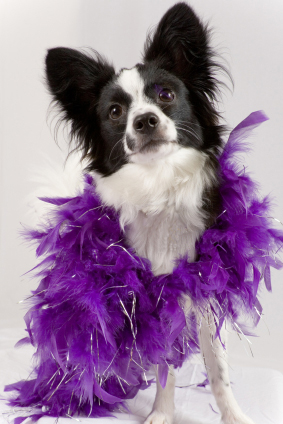QUESTION :Rover, our almost 9-month old, generally well-mannered dog, has developed some annoying behavior lately. He starts barking at random times to obviously get our attention, but it's a higher-pitched "yappy" bark. If we don't pay attention, he butts us with his head. His needs have been met (food, water, potty) and he has been very well exercised. What should we do?
ANSWER: Sounds like Rover, now a teen, is experimenting with some new behaviors to see if they work for him; trying to get your attention in various ways and "demanding" action from you. He's using all his best efforts to train you.
Time to fine tune a few details that may have slipped. When we start feeling that our puppies are pretty well-mannered (clean in the house, no more biting or inappropriate chewing), we often get a bit lax. After all, we've worked really hard for months, don't we deserve a little break? Unfortunately, just about that time, they become teenagers and we have to be vigilant all over again, just in a little different way.
Teen dogs (and kids) question the rules, test their boundaries, and try out new stuff. Sure they know a lot, but they often seem to forget or are unresponsive. It's normal. A study on teen humans showed that their brains actually go into a sort of rest state where it is really just busy processing all the stuff they have learned up to that point, but aren't taking in as much new info. I think of it as mental housekeeping time without much space for new info until the mess gets cleaned up. I imagine teen dogs experience a similar lull in their learning. No worries. It's a stage that passes.
So, what to do during this stage? Maintain routines. Keep asking for simple things you know they have already learned like sit, wait, come, etc. Try not to make these exercises too challenging, and practice many times a day as part of your normal routine. For example: sit to come out of the crate, go out the door, get fed, get petted, etc.
Be patient, but firm and consistent. In some cases, ignoring teen behaviors is really tough, especially if they are willing to escalate to worse barking and head butting like Rover. So take the "ignore" a step further and actually walk out on him if he acts this way. Since most likely what he wants is your attention, leaving the room deprives him of the opportunity for that attention. If you remain in the room, he keeps trying new (worse) things to see what will finally get you to pay attention to him. If you leave, he can't do that. Of course, you only leave for a minute or so and then calmly return. Repeat as often as needed.
His physical needs may have been met, but possibly not his mental or emotional needs. Do some short (3-5 min) training sessions several times a day, play with him, and make time to just sit and hang out for a few minutes. This will give him the attention he craves, but on your terms and for behaviors you like. During the rest of the day, make a special point to notice when he is calm and relaxed and "being good" (playing by himself, resting quietly, watching you work), and praise and reward him for those behaviors. Again, attention for stuff you like. You can keep some dry treats in strategic locations around the house (out of his reach) so you can quickly grab a treat if he is doing something nice. The more you notice and reward his "good" behaviors, the less he will need to resort to obnoxious behaviors.
Face it, there are times when we just can't "walk out" or attend to training the dog. Perhaps, for you, that's when you are busy getting the kids ready for school. You have a schedule to keep and they need your attention as well. At these times it is perfectly acceptable, and even desirable, to pen up the pup. You've fed, watered, and pottied him and spent a few minutes playing or cuddling. Then you put him in his pen or crate with a yummy chew and explain to him that now it's time you attended to the kids. Our dogs have to learn that they don't always (nor should they) "come first" and they must learn to be patient, relax, and entertain themselves.
Teen dogs may still need some limits set on their freedom (pen, leash, house line, etc.) to help them learn the self-control and patience they need to live with us. Pay attention to when Rover is most inclined to flip into one of his yappy states. Is he tired? Have you been at the computer too long? Has he been napping for hours and is now awake and bored?? Be proactive when possible to meet his needs before one of these moments comes up. If you know he has an issue just after a walk, or when the kids get home from school, use your pen to prevent him from making mistakes; maybe walk him before the kids arrive and then pen him for 20-30 minutes after walks to help him calm down again.
Hang in there. It will get better, but by all means take control of the situation rather than let him make the rules.



